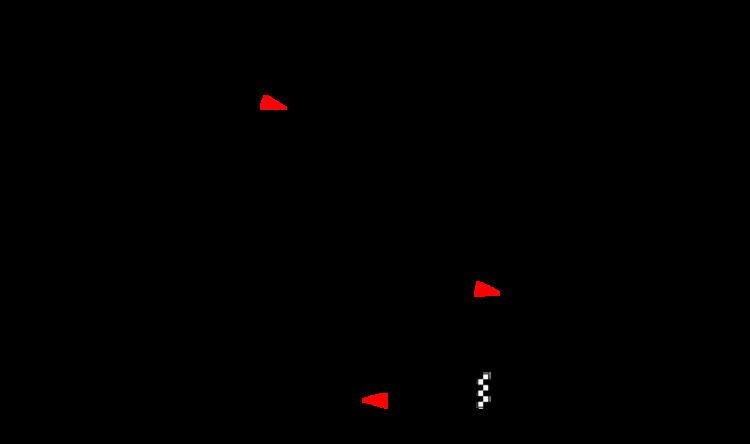Date August 18, 1985 | Course length 5.942 km (3.692 mi) | |
 | ||
Official name XVIII Holiday Großer Preis von Osterreich Course Permanent racing facility Distance 52 laps, 308.984 km (191.994 mi) | ||
The 1985 Austrian Grand Prix was a Formula One motor race held at Österreichring on August 18, 1985. It was the tenth round of the 1985 FIA Formula One World Championship. It was the 25th Austrian Grand Prix and the 24th to be held at Österreichring. The race was held over 52 laps of the six-kilometre circuit for a total race distance of 309 kilometres.
Contents
The race was won by French driver Alain Prost driving a McLaren MP4/2B. It was Prost's fourth victory of his championship-winning season. Prost won by 30 seconds over Brazilian driver Ayrton Senna driving a Lotus 97T. Italian driver Michele Alboreto driving a Ferrari 156/85 finished third, tying Alboreto and Prost in the championship.
In what was to be the last race for the venerable Cosworth DFV V8 engine until 1987, Tyrrell's Martin Brundle failed to qualify giving the race the distinction of being the first ever all-turbo Formula One Grand Prix starting a string of 22 races where all cars would be powered by turbocharged engines.
Race summary
Missing from the grid was RAM driver Manfred Winkelhock who had been killed in a sportscar race in Canada just a week before. His place was taken in the team by Kenny Acheson for his first Formula One race since the 1983 South African Grand Prix.
A second Toleman was driven by Piercarlo Ghinzani.
Before Saturday morning practice triple and defending World Champion (and 1984 Austrian Grand Prix winner) Niki Lauda, flanked by a very unhappy McLaren team boss Ron Dennis, announced to the media that he would be retiring for good from Formula One following the season ending Australian Grand Prix to concentrate on running his airline Lauda Air. Dennis was reportedly unhappy as he had paid Lauda a considerable amount of money to make his F1 comeback in 1982 and he had unsuccessfully tried to get Lauda to continue racing into the 1986 season.
A now relaxed Lauda gave his home fans something to cheer about when he qualified a season-high third. Lauda's team mate Alain Prost captured pole position, averaging 155.478 mph (250.219 km/h), followed by Nigel Mansell (Williams-Honda), Lauda, Keke Rosberg (Williams) and Nelson Piquet (Brabham-BMW). After a troubled qualifying, Senna only qualified 14th on the grid in his Lotus-Renault.
The race was restarted after one lap (with Niki Lauda having made a great start from third on the grid to lead Prost as the race was stopped). Mansell had got away very slowly in his Williams, but behind him Teo Fabi in the Toleman-Hart barely moved. Elio de Angelis (Lotus) dived left to avoid Fabi and was hit by the Ferrari of Alboreto. Fabi suffered damage as did the Arrows-BMW of Austria's "other" driver in the race Gerhard Berger. Luckily for those with damaged cars (especially championship leader Alboreto) the first lap was declared null and void and the race was completely restarted meaning those with damaged cars were permitted to start in the team spares. Lucky too was Prost who was able to change cars after his McLaren had developed a misfire. Piercarlo Ghinzani became a non-starter in his Toleman after team mate Fabi took over the spare TG185 for the race as he had qualified 6th while Ghinzani started 19th. This left Ghinzani without a drive.
On lap 13 Andrea de Cesaris survived one of the biggest crashes ever seen in Formula One when his Ligier-Renault got sideways at the left hand Panorama Curve and slid onto the outside grass at high speed. The grass, wet from overnight rain caused the Ligier to initially slide sideways before his right rear hit a slight bank launching the car into a series of rolls with de Cesaris's head bouncing around freely in the cockpit. Somehow as soon as the Ligier came to a rest (thankfully the right way up), de Cesaris undid his seat belts and walked away with nothing more than a mud-splattered helmet and driving suit. The crash was the end for de Cesaris at Ligier, with team owner Guy Ligier firing the Italian after he saw a replay of the crash stating "I can no longer afford to keep employing this man" referring to the constant repair bills from de Cesaris's crashes since he joined the team in 1984. When he returned to the pits, de Cesaris told the team that the reason for his DNF was that the car had stalled and wouldn't restart. It was reported at that point that the Ligier team had not seen a replay of the accident.
With his 20th career victory, Prost moved into a shared lead in the World Drivers' Championship alongside Alboreto, with each having 50 points. After a string of non-finishes since his win in the second race of the season in Portugal, Senna drove a great race into second from a lowly (for him) 14th on the grid, with Alboreto finishing third in the spare Ferrari to retain his lead in the World Championship (now shared with Prost). Stefan Johansson (Ferrari), Elio de Angelis, and Marc Surer (Brabham), completed the points-scoring finishers.
